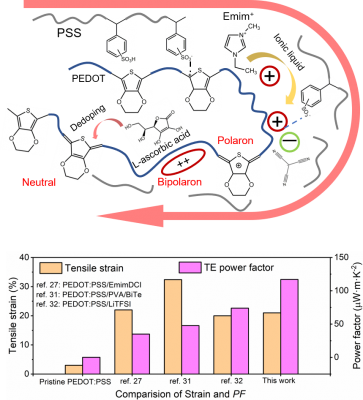New-generation thermoelectric materials now have a new method for optimizing their performance, thanks to the efforts of researchers at Southern University of Science and Technology (SUSTech).
Two papers from the research group of Associate Professor Weishu Liu (Materials Science and Engineering) have continued their studies into new room-temperature thermoelectric materials and applications. One paper, titled, “The Electronic Transport Channel Protection and Tuning in Real Space to Boost the Thermoelectric Performance of Mg3+δSb2-yBiy near Room Temperature,” was published in the high-impact academic journal Research. This journal is supported by the Chinese Association for Science and Technology (CAST) in conjunction with the American Association for the Advancement of Science (AAAS), under the Science Partner Journal (SPJ) program. The other paper was titled, “Enhanced thermoelectric performances of flexible PEDOT: PSS film by synergistically tuning the ordering structure and oxidation state,” and published in the high-impact journal Journal of Materiomics, supported by the Chinese Ceramics Society (CCS).
Thermoelectric materials directly convert thermal energy into electrical energy. Some of their advantages include the lack of moving parts, no pollution, and no noise. So far, the only mass-produced thermoelectric material is a bismuth-telluride (Bi2Te3) compound that is usually implemented in solid-state refrigeration but still lacks a substitute. However, Bi2Te3 is brittle, and tellurium is very scarce in the earth’s crust.
The development of the Internet of Things (IoT) technologies has seen a dramatic increase in the demand for high-performance room-temperature thermoelectric materials.
The paper published in Research, titled “The Electronic Transport Channel Protection and Tuning in Real Space to Boost the Thermoelectric Performance of Mg3+δSb2-yBiy near Room Temperature,” revealed the power factor gain strategy, based on electronic transmission channel protection.
The paper proposed the power factor enhancement strategy of the electron transport channel formed by the chemical bond between magnesium atoms (Mg-Mg) that are far away from the anion position. It makes the alloyed atom scatter phonons within the Mg3Sb2-yBiy material system to reduce the lattice thermal conductivity while scattering electron slightly, which benefits electron-phonon decoupling (Figure 1). As a result, the room temperature power factor significantly improve, with a conversion efficiency and output power comparable to commercial n-type Bi2 (Te, Se)3 thermoelectric materials.

Figure 1 The effective mass of electrons at the bottom of the conduction band is changed by adjusting the Mg1-Mg2 spacing
The paper shows that there is a power factor gain to be made at the effective mass of the band edge, with real space chemical bonds being important for optimizing high power factor thermoelectric materials.
Postgraduate student Zhijia Han and Research Assistant Professor Zhigang Gui (Physics) were the co-first authors. Weishu Liu and Physics Associate Professor Li Huang were co-correspondent authors. SUSTech was the sole correspondent unit. Other contributions came from the University of Science and Technology Beijing.
The paper received financial support from the State’s Key Project of Research and Development Plan, the National Natural Science Foundation of China, the Guangdong Innovative and Entrepreneurial Research Team Program, and the Shenzhen Basic Research Fund. The authors would also like to thank the support of the Centers for Mechanical Engineering Research and Education at MIT and SUSTech.
The second paper published in the Journal of Materiomics titled, “Enhanced thermoelectric performances of flexible PEDOT: PSS film by synergistically tuning the ordering structure and oxidation state,” optimized the oxidation state of conductive polymer chains, based on the previous research of ionic liquid-modified PEDOT/IL organic flexible thermoelectric thin films.
The researchers firstly treated PEDOT:PSS conductive polymers by ionic liquids to enhance the mechanical flexibility of the hybrid PEDOT:PSS/IL films. In view of the general TE power factor obtained, their experiments further optimized the Seebeck coefficient to achieve better thermoelectric conversion efficiency. In this work, they proposed a solution post-treatment method to be applied for treating the PEDOT: PSS/IL film with a reducing agent to adjust the oxidation state of the conductive polymer chain.
Through this post-treatment with the reducing agent, the PEDOT polymer is effectively reduced, along with its carrier concentration, thereby regulating the conductive polymer and its role in the electronic structure. The Seebeck coefficient increased significantly following the de-doping, as did the room temperature power factor. The film also retained much of its tensile strength, being able to maintain its electrical stability over one thousand bending cycles.

Figure 2 The optimization strategy of the secondary treatment of the ionic liquid EMImTCM and the reducing agent vitamin C and the simultaneously improved material power factor and tensile strain
The idea of regulating the oxidation state of conductive polymer based on the secondary treatment of ionic liquid and reducing agent revealed by the researchers in this work, through the double regulation of the conductive polymer chain structure order and oxidation state. The optimization of flexible thermoelectric materials has important guiding significance.
Doctoral student Qikai Li is the first author. Weishu Liu is the corresponding author, and SUSTech is the only correspondent unit.
The paper received financial support from the Guangdong Innovative and Entrepreneurial Research Team Program, the Shenzhen Science Technology Fund, and the Shenzhen DRC Fund. The authors would also like to thank the support of the Centers for Mechanical Engineering Research and Education at MIT and SUSTech.
Article link:
https://spj.sciencemag.org/research/2020/1672051/
https://linkinghub.elsevier.com/retrieve/pii/S2352847819302151






